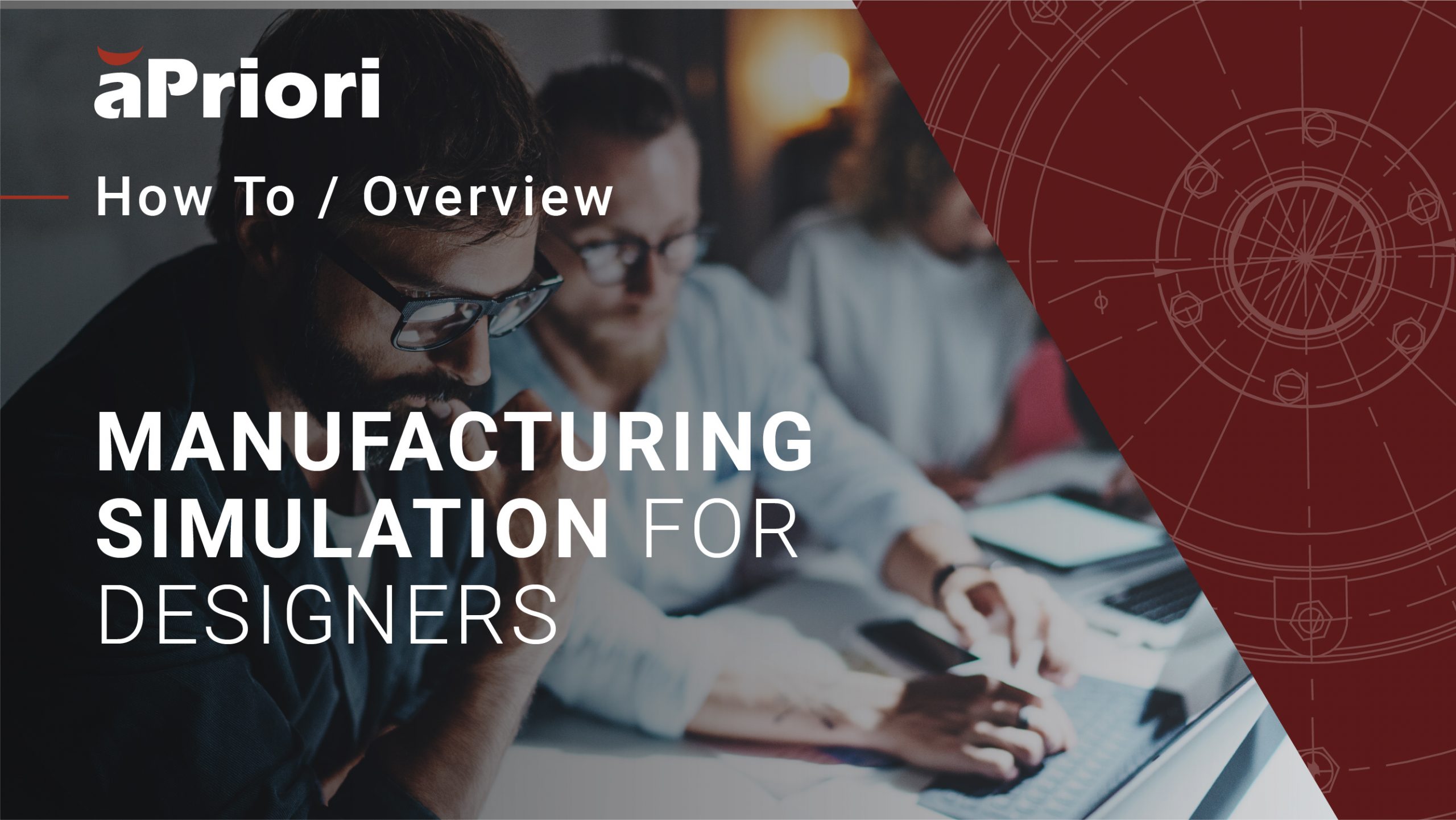Video
Manufacturing Simulation Software for Product Designers
Designers are under an enormous amount of pressure. Everyone from finance, to procurement, to shareholders is relying on designers to design for manufacturability and for cost. All while driving new innovation to beat the competition.
But design for manufacturability and design to cost has never been easier. aPriori was built for designers by designers to make it easy to understand what elements of your CAD design will be expensive or difficult to manufacture. So you can make real-time changes to your model.
CAD model heat-mapping shows you exactly where potential problems in your design may be. So you can fix potential problems earlier in the design process. Watch this 10-minute live demo to see how designers are using aPriori to eliminate cost drivers in real time.

Transcript
The Design Process for Design Engineers Is Expanding to Include Cost
The focus on cost in the engineering departments of organizations varies from industry to industry, from company to company, and from culture to culture. This is very simple reason in that engineers primarily focus on designing stuff. That’s their number one job. This product here, for example, needs to perform to its specification, needs to be efficient, needs to be green and lean, needs to provide enough power and thrust. But most importantly, it needs to be safe, its primary function is to keep that aircraft in the sky. And cost becomes a close second, but it’s increasingly more and more important for organizations that develop products. These pressures around cost come from different areas. Traditionally, they’ve come from finance, procurement, or even program management, where the program manager needs to ensure that product design is meeting its budget constraints and is being to market on time. The pressure is also coming from the world of value engineering, from the competition and the shareholders. The marketplace is creating pressures on the design teams to focus on cost early on. Of course, we cannot afford to compromise the most important thing, and that’s meeting the requirements of the design, especially if safety is a big factor.
New Product Development: It is Possible to Focus on Cost and Innovation Simultaneously
But we can focus on cost and focus on innovation at the same time. In fact, if we do, it helps our innovation challenge. If we think about the progress of developing the digital twin, the definition of our product, if we don’t define it right or we get things wrong, we end up with lots of unnecessary change at the end because of design to cost or manufacturability errors. And making changes at this end of the life cycles, very time consuming and difficult. We’d rather incorporate it early on and avoid this late stage change. So we would like to focus on cost and manufacturability early on so we can eliminate that late stage change. And that actually releases more time for engineers to focus on what they do best, innovation, and doing it with a finite amount of resources in the business to create the best products, but that are affordable and right for the business.
aPriori: The Product Design Software to Streamline the Product Development Process
Over the period of that lifecycle, the ability to influence cost goes in the opposite direction, and that’s why aPriori uses the digital twin to simulate, manufacture, to understand where these issues may lie during the design phase. So how does aPriori support the engineer then? Well, first of all, we are going to do this without intruding too much on the engineer’s primary role. Therefore, we’re gonna use aPriori’s aP Generate, which does a simulation in the background and produces reports.
How Does aP Generate Work in Real Time?
The product design engineer simply uploads their 3D CAD model into aPriori, and aP Generate will use automation to inform engineers and anybody else involved in the process of things they need to consider when they need to consider them. So here for example, is a list of components, one of which has got a high risk for manufacturability. So of all the things I could think about from a cost perspective, this could be my number one target, my number one priority. Within the email is a link to the definition of that part. It takes me to my PLM system where it is controlled and managed. And with that part, inside PLM, there’s documentation that is used to specify it throughout its lifecycle. Here, for example, is the report that was generated by aP Generate. And in this report is the assumptions that were made during the simulation and also the issues themselves. These are the things that are gonna make it slightly harder to manufacture and therefore impact cost. And I’m being informed of these early on in the process, so I now have the opportunity to do something about it.
But what’s really important is, how do I actually solve those issues? What are they? So, also attached to the part is the simulation itself. This is a simulation that’s performed by aPriori on my behalf in the background. And now as a design engineer looking to improve my product design process workflow, all I need to do is read through the series of issues and understand if I can accommodate them in the design without compromising design quality. This is a flywheel. It sits within a driven system of a drill. And that flywheel has two functions. One is to provide rotating mask to retain inertia, and the other function is to provide cooling for the motor, which it is driven by. So I’ve elected to design it with large counterweights and some fins, and then I’ve got some structure to hold it all together as a single die casting part. As you can see over here.
Now, down below here is a series of issues I need to now look at and consider. The first one here is void geometry. I’ve designed voids into this component, which are not possible to make in a traditional die casting tool, and therefore I need to know about this now because I could send this off to the supplier for prototyping. They could go to the toolmaker, they could have a discussion about whether this is really required, come back to me a few days or even weeks later and have a discussion on email. They could just delay the whole process of getting the first component made.
I also have issues around draft as well. And there’s a similar situation here, whereas if I don’t consider draft angle in the design and all these yellow surfaces don’t have any draft on them or don’t have enough draft based on the requirements for manufacture, then I could send this to supplier. And again, I could take a few days or weeks to iterate and to get through the conversation about what the assumptions are and how they’re going to do this. Or I could leave it entirely up to the toolmaker and I may get a compromised design at the end of the process ’cause they’ve made some assumptions, which I should have been involved in the process of doing.
Either way, it’s either going to lead to quality issues, yield issues, or delays in production. There are some blind holes in this component. Blind holes are fine. I designed them in because that’s what I wanted to do. And if I want to understand why they’re an issue, then aPriori already gives me a bit more information. And for each of these other guidance elements too, I can see why. So for blind holes, I need pins in the tool and small pins can be fragile, delicate. They can bend and skew and they can just cost more money to develop the tool with. If I used a through hole, then the pin was supported at either end and it’d be a better casting that came out and perhaps a cheaper tool to manufacture and maintain. So it’s just saying if that hole could be a through hole, which it could be, I was just thinking about this from a machining perspective, I could cast that in as a through hole and just tap it in a machining process later on.
aP Generate also tells me where I’ve violated the rules around minimum or maximum wall thickness in castings. Here, my minimum wall thickness is 0.4 millimeters and the minimum suggested is 0.5 millimeters. And if I want to understand where these thin and thick walls reside, then aPriori can show me in the model where they are precisely. And I can use it, tools with aPriori to do a lot more investigation if this really is something I want to go and understand more about.
Also, in this list of issues there are other things that are minimum edge radius and so on. It shows me all the features that are gonna be created by machining operations. And this is dependent on manufacturing feasibility and tolerances. So if a hole cannot be cast to the right size or tolerance, then it will be machined. And aPriori knows this, so it works out what needs to be machined. And here is a list of the process elements required to make it. And I can see that machining, for example, represents nearly 11% of the total cost of the part. So if I want to take 11% out, I could think about a design of this that doesn’t require any machining operations and I can save a significant amount of money.
So given this guidance, I need to then rethink about the design and accommodate the input into my new version. So I’ve gone and done that. And I do this in my computer-aided design 3D CAD software, this is Creo I’m using for CAD design and I’ve designed my new component. And now I need to understand if it is going to be a better component from a cost perspective. So I send it up to aPriori’s Cloud to get it evaluated. All that’s happening here is it’s uploading the CAN mold to our secure Cloud environment where the simulations are going to take place. Now the simulation takes only a few seconds or a few minutes to do, which is great because it would normally take a few days or weeks. And while it’s doing that, it’s translating the geometry, it’s gonna process it through a manufacturing process in a digital factory and it’ll come back within a few seconds with an answer.
aP Generate is For Both Beginners and Advanced Product Designers
But from a designer’s perspective, I get on with doing what I’m supposed to be doing, designing world-class products and let aPriori do the simulation, let aPriori identify where the challenges are going to be and then it’ll just tell me. Now what I’ve done with this designers, I’ve removed the counterweights as you can see, and instead of having the counterweight rotating mass, I’ve put the mass into the fins, the fins that do the cooling operation. And therefore I’ve got all the rotating mass on the outside and the fins, but not in big lumps of material which take up cycle time in the tool take longer to cool. I don’t have the thin fins that I was using to support them, and it’s just a simpler design. In fact, what I’ve done here is accommodate a two for one. I’ve thought of it manufacturability and the design at the same time, the fins now provide two functions in one single feature, which is good from all sorts of perspectives. So once it’s finished the simulation, it gives me a result. So here’s the new design. The result suggests that the cost has now gone down to $166. So it’s a much cheaper component to manufacture.
How much cheaper is it compared to the old one? Well, then aPriori can run comparisons very easily just to compare one design to the other. And here I’m looking at them side by side. The direction and the colors of the arrows suggest changes in the different factors. I can see that it is gone from a critical state of design for manufacturability to low risk. And the overall cost has gone from 194 down to 166. And that saving over the life of that part represents about a $100,000 saving. Just for one simple piece of advice that aPriori gave me, and I’ve done this within a few minutes with minimal interaction with the simulation itself and just taking advice and using it to alter the design. And that’s how aPriori supports design engineers. It provides guidance when it needs to be given. And cost insight generate is the place where the simulation is performed automatically and managed within our product lifecycle management tool, in this case was Windchill.

